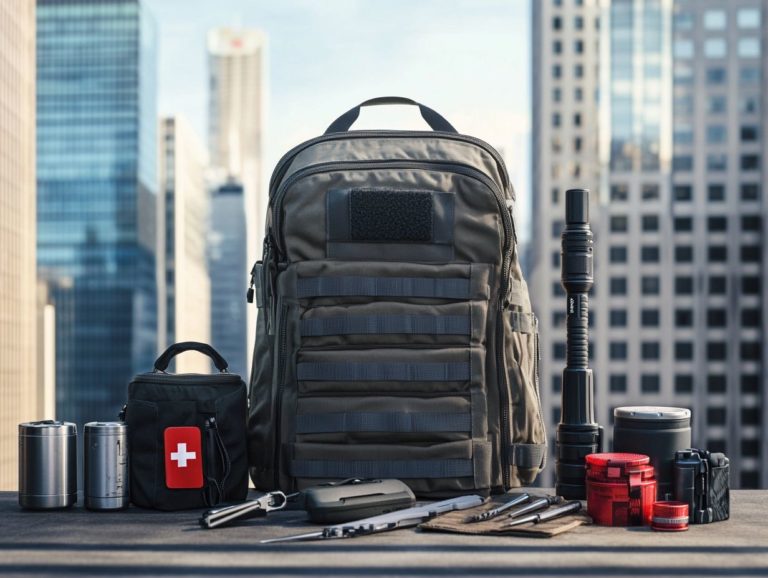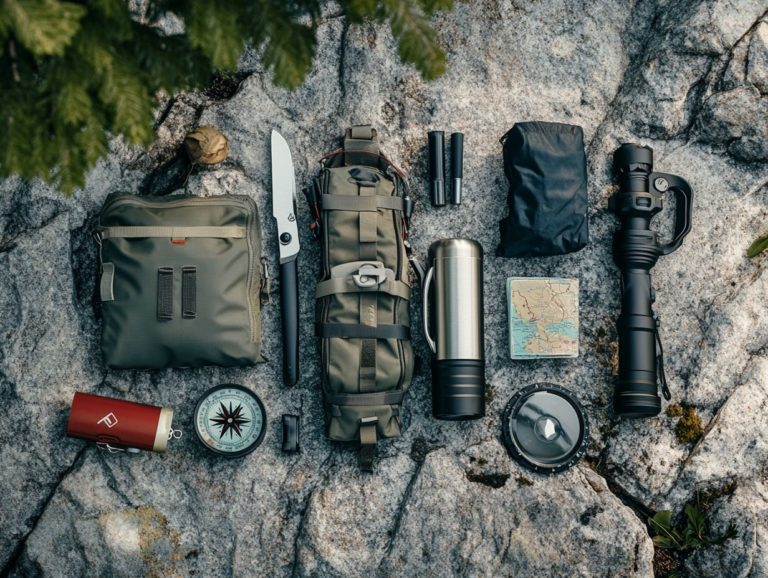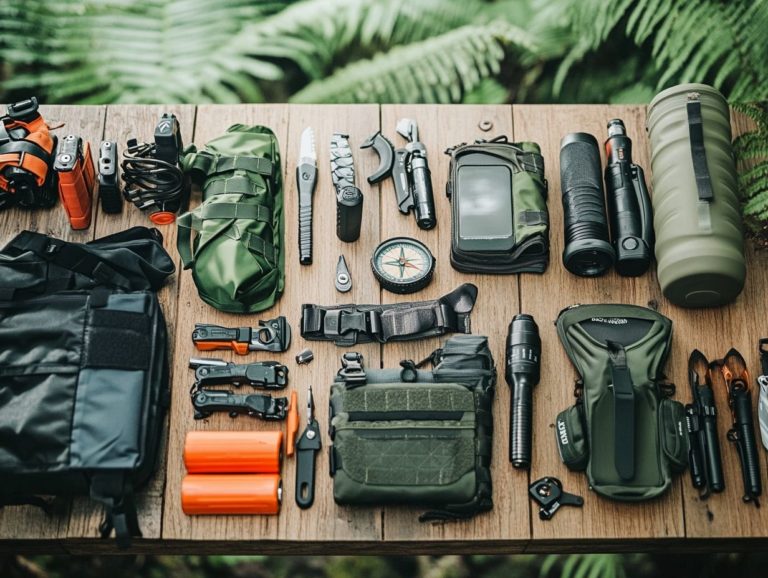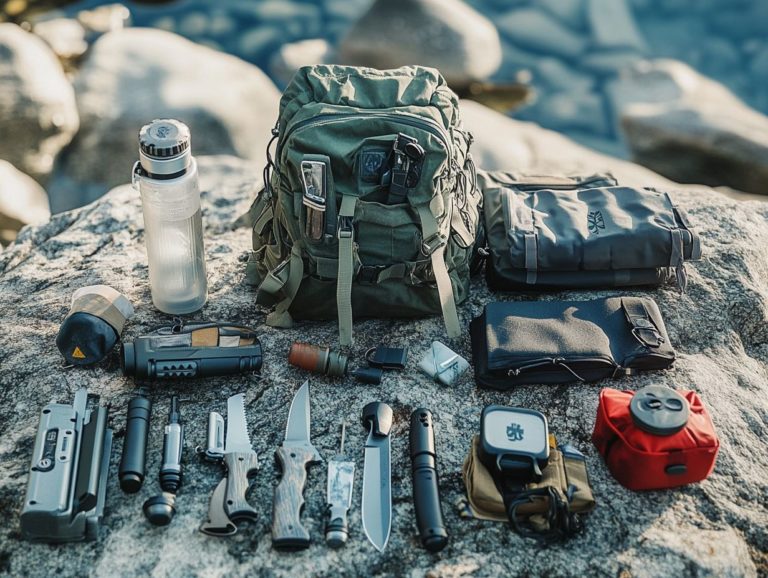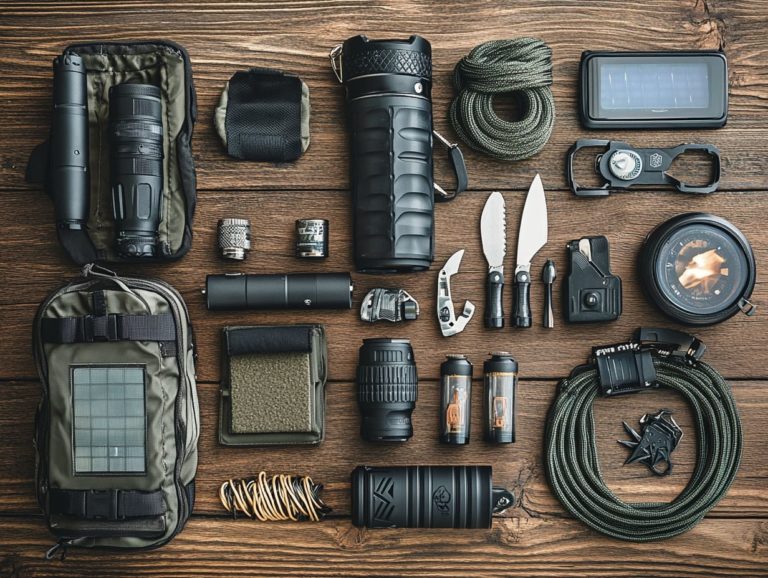Creating a Survival Gear Plan for Your Family
In today s unpredictable landscape, preparing your family for potential emergencies has become a paramount concern. This guide provides essential steps to craft a survival gear plan that covers everything you need, tailored specifically to your unique circumstances.
From assessing risks and gathering necessary supplies to organizing a detailed checklist and ensuring proper maintenance, this information encompasses everything you need to keep your loved ones safe and equipped for any situation. Let s dive into how you can create a strong safety net for your family, ready for any challenge!
Contents
- Key Takeaways:
- Assessing Your Family’s Needs
- Essential Items for a Survival Gear Plan
- Creating a Survival Gear Checklist
- Organizing and Prioritizing Supplies
- Storing and Maintaining Your Survival Gear
- Frequently Asked Questions
- What is a survival gear plan?
- Why is it important to have a survival gear plan for your family?
- How do I create a survival gear plan for my family?
- What items should I include in a survival gear plan for my family?
- How often should I update my family’s survival gear plan?
- Should I involve my family in creating a survival gear plan?
Key Takeaways:
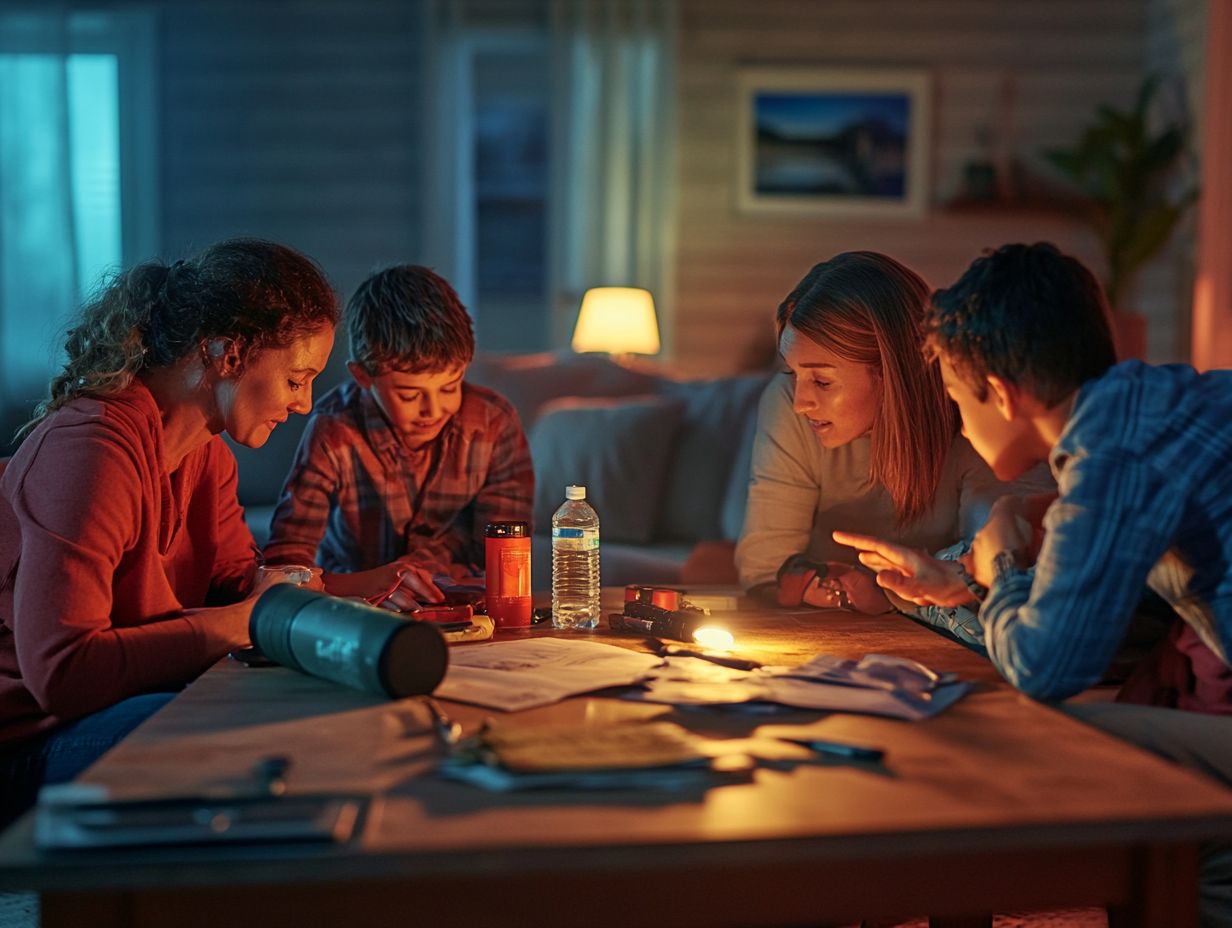
- Assess potential risks and disasters that may affect your family, such as natural disasters or power outages, to determine necessary supplies for a survival gear plan.
- Essential items for a survival gear plan include food, water, shelter, clothing, first aid and medical supplies, and tools and equipment.
- Create a checklist to organize and prioritize your supplies, and regularly maintain and replenish them to ensure their effectiveness in times of emergency.
Assessing Your Family’s Needs
Assessing your family’s needs is an essential first step in ensuring safety and preparedness for natural disasters. By understanding the specific requirements of each family member children, seniors, and pets you can create a comprehensive emergency kit.
This kit should include vital items such as bottled water, non-perishable food, and a first aid kit. Identify potential risks in your area to inform your evacuation plan and help you determine the necessary supplies to include in your survival kit.
Identifying Potential Risks and Disasters
Identifying potential risks and disasters is crucial for your family s preparedness. This understanding allows you to customize your emergency supplies to suit your specific needs.
By knowing the types of natural disasters, such as floods, earthquakes, and wildfires, you can create plans that address the particular threats you may encounter. For example, preparing for flooding means you’ll need waterproof storage for important documents and specific emergency supplies like life jackets and water purification tablets. Additionally, consider creating an affordable survival gear kit to ensure you are well-prepared for any situation.
Being aware of local hazards boosts your readiness and enables you to strategize evacuation routes and pinpoint safe shelters when the need arises.
Determining Necessary Supplies
Determining the necessary supplies for your emergency kit requires understanding the essential items that will cater to your family s specific needs during a disaster. A well-prepared emergency kit should feature at least three days’ worth of non-perishable food items, such as canned goods and energy bars.
You should also ensure you have at least one gallon of water per person per day. Additionally, include a reliable method to make water safe to drink.
Don’t overlook medical supplies; stocking a first aid kit with bandages, antiseptics, and any critical medications will ensure you re ready for minor injuries or health issues. Personal hygiene items, like soap and sanitizers, are equally important to help maintain health in uncomfortable situations.
Having cash on hand can provide an extra layer of security, as ATMs and digital payment methods may not be accessible during power outages.
Essential Items for a Survival Gear Plan
Crafting a survival gear plan requires you to carefully choose essential items that will act as your lifeline in times of crisis. It s crucial to ensure that you have access to food supplies, clean drinking water, and vital emergency essentials, such as a first aid kit.
Taking the time to prepare will enable you to face unexpected challenges with confidence and security. To help you get started, check out this guide on how to choose the right survival gear for you and start gathering your supplies today to ensure your family’s safety!
Food and Water

Food and water are the cornerstones of any survival gear plan. Non-perishable food and bottled water are essential for keeping your family safe during an emergency.
Ensure you have a balanced supply of these items. They provide the necessary nutrients and hydration when normal grocery access may be cut off.
Experts recommend having at least one gallon of bottled water per person per day for at least three days. This underscores the importance of planning ahead.
Select food supplies that are high in protein and low in sodium. Look for items with a long shelf life, such as:
- Canned fruits
- Whole grains
- Dehydrated meals
Consider any dietary restrictions in your family. Regularly rotating your stock keeps everything fresh.
Shelter and Clothing
Shelter and clothing are vital for survival during emergencies. Items like emergency blankets and warm clothing protect against harsh conditions.
Selecting the right clothing is key for comfort and safety in various climates. Proper layering helps regulate body temperature, and waterproof gear protects against rain and snow.
Lightweight stoves can help you cook nourishing meals. Keeping your energy levels up is crucial when challenges arise.
First Aid and Medical Supplies
A well-stocked first aid kit is vital for treating injuries during emergencies. Having the right items can mean the difference between quick care and complications.
Basic items to include are:
- Adhesive bandages
- Sterile gauze pads
- Antiseptic wipes
- Tweezers
Over-the-counter medications like ibuprofen and antihistamines are crucial for common ailments. Keep your kits updated; replace expired items regularly.
Tools and Equipment
Having the right tools and gear boosts your preparedness. Essentials like a multi-tool, fire starter, and battery-powered radio are critical in emergencies.
These items help you face unexpected challenges effectively. A multi-tool combines functions like cutting and screwing, making it invaluable in tough situations.
A reliable fire starter provides warmth and can signal for help. A battery-powered radio keeps you updated on weather and emergency alerts.
Creating a Survival Gear Checklist
Creating a survival gear checklist is essential. This step helps ensure you have everything prepared and accessible.
Organizing and Prioritizing Supplies

Organizing and prioritizing supplies in your survival kit is crucial. This ensures quick access to emergency essentials during a crisis.
Effective organization significantly boosts your chances of staying safe and connected when the unexpected strikes. One effective strategy is to categorize items by urgency and necessity. This allows you to locate critical supplies with ease. For example, grouping first aid materials, food, water, and tools separately provides a systematic approach to handling emergencies. Additionally, knowing what to include in your survival gear kit can enhance your preparedness.
Regularly reviewing and updating your supplies keeps you ready for anything that comes your way! Utilizing clear containers or labeled bags can further simplify the process. This makes it easier for you or anyone assisting you to evacuate quickly or lend a helping hand during a crisis. For urban settings, consider investing in survival gear for urban environments to ensure you’re well-prepared.
Storing and Maintaining Your Survival Gear
Storing and maintaining your survival gear with precision is essential for ensuring that your emergency supplies remain effective and accessible when needed.
Proper organization not only safeguards your equipment but also prepares you for unexpected situations.
Proper Storage Techniques
Proper storage techniques for emergency supplies are essential in ensuring that your items remain in prime condition and are readily accessible when a crisis strikes.
Using waterproof containers is a smart move; they protect your supplies from potential water damage, which is crucial if you live in a flood-prone area. By categorizing your supplies—think food, medical equipment, and tools—you enable quick retrieval when every second counts. Additionally, consider investing in survival gear for family camping trips to enhance your preparedness.
Adding clear labels to each container takes organization to the next level. This allows you to locate everything you need without hassle. Embracing these effective storage strategies not only safeguards your essential items but also fosters a sense of preparedness. To enhance your readiness, consider learning how to create a personalized survival gear kit, enabling you to navigate emergencies with confidence.
Regular Maintenance and Replenishment
Regularly maintaining and replenishing your emergency supplies is vital to ensure they remain effective when you need them most.
By routinely checking expiration dates, you can pinpoint which items may have lost their potency, whether it’s first-aid kits or food reserves. It’s not merely about having supplies at the ready; it’s crucial to replace used items and verify that everything is functioning properly, especially tools or medications that could be essential in a pinch.
Use this checklist for essential items:
- Batteries
- Flashlights
- Non-perishable food
This proactive approach cultivates peace of mind, enabling you to be prepared for any unexpected situation that may come your way.
Frequently Asked Questions
What is a survival gear plan?
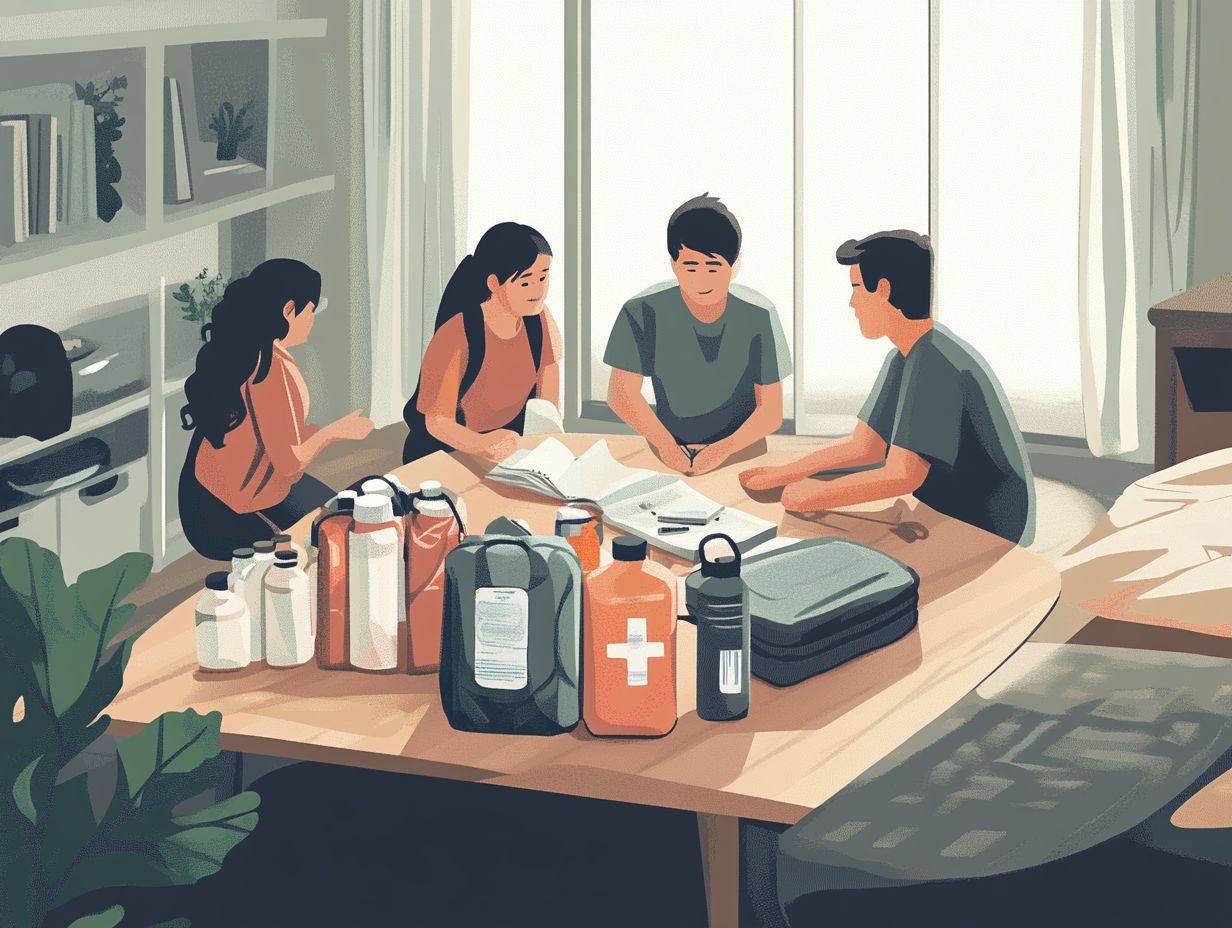
A survival gear plan is a comprehensive and organized list of essential items and supplies that your family will need in the event of an emergency or disaster.
Why is it important to have a survival gear plan for your family?
In the event of a disaster or emergency, having a survival gear plan can mean the difference between life and death. It ensures that your family is prepared and has the necessary supplies to survive until help arrives.
How do I create a survival gear plan for my family?
Start by assessing the needs of your family, including any medical conditions or special requirements. Then, research and make a list of essential items such as food, water, shelter, and first aid supplies. Finally, gather and organize these items into a designated location for easy access.
What items should I include in a survival gear plan for my family?
Some key items to include are non-perishable food, water, first aid supplies, a battery-powered radio, flashlights, warm clothing, and a multi-purpose tool. Consider the needs of your family when deciding on specific items to include.
How often should I update my family’s survival gear plan?
Review your family’s survival gear plan at least once a year.
This is your chance to check for expired supplies and make necessary updates!
Should I involve my family in creating a survival gear plan?
Yes! Involving your family in the plan is crucial.
It helps them grasp the importance of being prepared and lets them suggest items they might need in an emergency.

